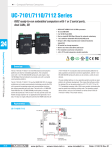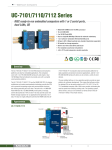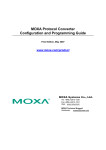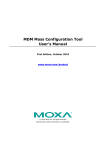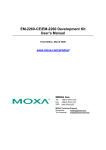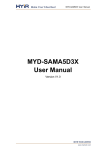Download Moxa Device manager User's Guide v1
Transcript
Moxa Device Manager 2.0 User’s Guide First Edition, March 2009 www.moxa.com/product © 2009 Moxa Inc. All rights reserved. Reproduction without permission is prohibited. Moxa Device Manager 2.0 User Guide The software described in this manual is furnished under a license agreement and may be used only in accordance with the terms of that agreement. Copyright Notice Copyright © 2009 Moxa Inc. All rights reserved. Reproduction without permission is prohibited. Trademarks MOXA is a registered trademark of Moxa Inc. All other trademarks or registered marks in this manual belong to their respective manufacturers. Disclaimer Information in this document is subject to change without notice and does not represent a commitment on the part of Moxa. Moxa provides this document “as is,” without warranty of any kind, either expressed or implied, including, but not limited to, its particular purpose. Moxa reserves the right to make improvements and/or changes to this manual, or to the products and/or the programs described in this manual, at any time. Information provided in this manual is intended to be accurate and reliable. However, Moxa assumes no responsibility for its use, or for any infringements on the rights of third parties that may result from its use. This product might include unintentional technical or typographical errors. Changes are periodically made to the information herein to correct such errors, and these changes are incorporated into new editions of the publication. Technical Support Contact Information www.moxa.com/support Moxa Americas: Toll-free: 1-888-669-2872 Tel: +1-714-528-6777 Fax: +1-714-528-6778 Moxa China (Shanghai office): Toll-free: 800-820-5036 Tel: +86-21-5258-9955 Fax: +86-10-6872-3958 Moxa Europe: Tel: +49-89-3 70 03 99-0 Fax: +49-89-3 70 03 99-99 Moxa Asia-Pacific: Tel: +886-2-8919-1230 Fax: +886-2-8919-1231 Table of Contents Chapter 1 Introduction........................................................................................................1-1 Overview ............................................................................................................................ 1-2 Differences between MDM 2.0 and MDM 1.1 .................................................................. 1-2 Chapter 2 Installation..........................................................................................................2-1 Installation.......................................................................................................................... 2-2 Installing MDM Agent ....................................................................................................... 2-3 Installing MDM Agent on Linux Models ............................................................... 2-3 Installing MDM Agent on Windows XPE Models ................................................. 2-4 Installing MDM Agent on Windows CE Models.................................................... 2-4 Uninstalling MDM Agent................................................................................................... 2-5 Uninstalling MDM Agent on Linux Models........................................................... 2-5 Uninstalling MDM Agent on Windows XPE Models............................................. 2-5 Uninstalling MDM Agent on Windows CE Models ............................................... 2-5 Installing MDM Gateway................................................................................................... 2-5 Uninstalling MDM Gateway .............................................................................................. 2-6 Installing MDM Tool.......................................................................................................... 2-6 Uninstalling MDM Tool..................................................................................................... 2-9 Chapter 3 MDM Operation ..................................................................................................3-1 Launching MDM Agent ..................................................................................................... 3-2 Launching MDM Tool........................................................................................................ 3-2 Connecting to MDM Gateway ........................................................................................... 3-3 Introduction to the MDM Tool Interface............................................................................ 3-6 Menu Bar Introduction............................................................................................ 3-7 Toolbar Functions............................................................................................................... 3-9 Uploading Files....................................................................................................... 3-9 Upgrading the Firmware ....................................................................................... 3-12 File Manager ......................................................................................................... 3-14 Viewing Upload/Download Status........................................................................ 3-18 Controlling the Process ......................................................................................... 3-20 Setting Up the Network......................................................................................... 3-22 Autolaunch............................................................................................................ 3-25 Setting Up the Time .............................................................................................. 3-26 Rebooting the Computer ....................................................................................... 3-27 Disconnecting MDM Gateway......................................................................................... 3-27 How to Exit MDM Tool ................................................................................................... 3-28 1 Chapter 1 Introduction Moxa Device Manager (referred to in this manual as MDM) is an easy-to-use remote management tool for managing Moxa’s ready-to-run embedded computers on the Internet. Moxa’s embedded computers make excellent front-end computers for onsite data acquisition and industrial control applications, but they are often located at a remote site. MDM was designed to make it easy for system administrators to manage their remote embedded computers. This chapter covers the following topics: Overview Differences between MDM 2.0 and MDM 1.1 Moxa Device Manager 2.0 User’s Guide Introduction Overview Moxa Device Manager (MDM for short) is an easy-to-use remote management tool for managing Moxa’s ready-to-run embedded computers on the Internet. Moxa’s embedded computers make excellent front-end computers at remote sites for on-site data collection and industrial control applications. MDM is designed to make it easy for system administrators to manage their remote embedded computers. One of the key benefits of MDM is that management tasks, such as configuring the network, managing and/or transmitting text and binary files, and monitoring and controlling processes, can be handled easily using a Windows-based user interface. In addition, MDM can be used to manage different models of embedded computer, and embedded computers that use different operating systems, all from one centrally located computer. As long as the individual embedded computers are preinstalled with an MDM agent, they can be recognized and managed by the unified MDM tool from your PC. These features help ensure that MDM gives system integrators an efficient tool for handling all remote devices from one computer. Differences between MDM 2.0 and MDM 1.1 1. MDM 2.0 can operate over the Internet whereas MDM 1.1 can only operate over a LAN (Local Area Network). 2. MDM 2.0 supports all models and all operating systems (Linux, CE, XPe) of Moxa’s embedded computers whereas MDM 1.1 only supports selected models and operating systems. 3. MDM 2.0 provides a more friendly graphical user interface that allows users to “click and operate” to manage remote devices. Note: In this manual, Moxa’s embedded computers are referred to as “computer,” “embedded computer,” or simply as “device.” 1-2 2 Chapter 2 This chapter covers the following topics: Installation Installing MDM Agent Uninstalling MDM Agent Installing MDM Gateway Uninstalling MDM Gateway Installing MDM Tool Uninstalling MDM Tool Installation Moxa Device Manager User Guide Installation Installation To use MDM to remotely monitor and manage Moxa’s embedded computers, you need to install three software programs in three separate locations: a. MDM Agent: This program must be installed on embedded computers at remote sites so that they can be easily monitored and managed remotely. b. MDM Gateway: This program must be installed on the computer(s) used as the MDM Gateway. It serves as a portal between two programs, allowing them to share information by communicating between protocols on the same computer or between computers. MDM Gateway can be used to connect to many embedded computers at remote sites, so that a centralized management architecture can be established. c. MDM Tool: This program is installed on the computer, usually a PC or a laptop, in the control center. It allows users to connect the MDM Gateway to monitor and manage the remote embedded computers. 2-2 Moxa Device Manager User Guide Installation Installing MDM Agent MDM Agent should be installed on remote embedded computers that you would like to monitor and manage. Separate instructions are given below for different operating systems. Installing MDM Agent on Linux Models 1. Download the MDM Agent for the model of embedded computer you are using from Moxa’s website. 2. Use FTP to upload the files to the embedded computer’s /tmp directory. 3. Log in to the remote embedded computer as root. 4. Next, type the following commands: cd /home tar xvzf /tmp/MDM2_Agent-UC-74XX_DA-660-LX.tar.gz For UC7101/7110/7112 and EM1220/1240 models, type the following commands: gunzip /tmp/MDM2_Agent-UC-7112-LX.tar.gz tar xvf /tmp/MDM2_Agent-UC-7112-LX.tar.gz Note: The file name of the MDM Agent installation file includes the product model name. 5. View the file list for directory /home/mdm. The files you should see are described below: File Name MDM2-uc74xx.exe mdm.sh mdm2 mdm_start.sh mdm_stop.sh Description MDM Agent executable MDM Agent watch dog script MDM Agent MDM Agent start script MDM Agent stop script Note: The file name of the executable file is different for different models. 6. How to start MDM Agent: Type the following command to start MDM Agent manually: /home/mdm/mdm_start.sh You can also set up your embedded computer to launch MDM Agent automatically via AutoLaunch function of MDM Tool. Alternatively, you can add the command /home/mdm/mdm_start.sh manually to the file rc.local. 7. How to stop MDM Agent: Type the following command to stop MDM Agent manually: /home/mdm/mdm_stop.sh You may also shut down or power off the computer to stop MDM Agent. 2-3 Moxa Device Manager User Guide Installation Installing MDM Agent on Windows XPE Models 1. Download the MDM Agent for the model of embedded computer you are using from Moxa’s website. 2. Unzip the archive first, and then use FTP to upload file to the embedded computer. 3. Log in to the embedded computer as Administrator. 4. Unzip MDM2_Agent-XPe.zip to the folder of your choice (e.g., C:\) Open a DOS window Type: cd C:\MDMAgent Execute Autolaunch.exe install to install AutoLaunch service. Start AutoLaunch, which is in the following location: Start menu Control Panel Administrative Tools Start Service Services Auto Launch 5. View the file list in folder C:\MDMAgent. The files you should see are described below: File AutoLaunch.exe MDMAgent.exe Description Auto-launch service MDM Agent executable 6. How to start MDM Agent: Double click MDMAgent.exe to start MDM Agent manually. You can also set up your embedded computer to launch MDM Agent automatically via AutoLaunch function of MDM Tool. 7. How to stop MDM Agent: Use Task Manager to stop MDMAgent.exe manually. You may also shut down or power off the computer to stop MDM Agent. Installing MDM Agent on Windows CE Models 1. Download the MDM Agent for the model of embedded computer you are using from Moxa’s website. 2. Unzip the archive first, and then use FTP to upload file to the embedded computer. 3. Log in to the embedded computer as Administrator. 4. Unzip MDM2_Agent-IA26X-CE.zip to the \NORFlash directory. 5. View the file list in the \NORFlash directory and verify that the file MDMAgent.exe is present. 6. How to start MDM Agent: Double click MDMAgent.exe to start MDM Agent manually. You can also set up your embedded computer to launch MDM Agent automatically via AutoLaunch function of MDM Tool. 2-4 Moxa Device Manager User Guide Installation 7. How to stop MDM Agent: Use Web Manager to stop MDMAgent.exe manually. You may also shut down or power off the computer to stop MDM Agent. Uninstalling MDM Agent Uninstalling MDM Agent on Linux Models 1. Log in to the remote embedded computer as root. 2. Stop MDM Agent. 3. Issue the following command: rm -r /home/mdm Uninstalling MDM Agent on Windows XPE Models 1. Stop MDMAgent.exe. 2. Stop AutoLaunch.exe service by clicking: Start menu Control Panel Administrative Tools stop Services Auto Launch 3. Remove MDM Agent from the folder C:\MDMAgent. Uninstalling MDM Agent on Windows CE Models 1. Stop MDMAgent.exe. 2. Remove MDMAgent.exe. Installing MDM Gateway MDM Gateway should be installed on the computers that you will use as the MDM Gateway that the remote embedded computers connect to. Please note that the computer used as the MDM Gateway Server must be installed with the Windows XP operating system. Follow these steps to install MDM Gateway. 1. Download the MDM Gateway from Moxa’s website. 2. Use FTP to upload the files to the Gateway computer, or use a USB disk to copy the files to the Gateway computer. 3. Log in to the computer as Administrator. 4. Unzip MDM2_Gateway-XP.zip to the folder of your choice (e.g., C:\). 5. View the file list in folder C:\MDMGw. 6. How to start MDM Gateway: To start MDM Gateway, log in to the computer and run MDMGw.exe. 7. How to stop MDM Gateway: Use Task Manager to stop MDMGw.exe manually. You may also shut down or power off the computer to stop the MDM Gateway program. 2-5 Moxa Device Manager User Guide Installation Note: If you bring up MDM Gateway from a DOS window, you can press Ctrl+Break to stop MDM Gateway. Uninstalling MDM Gateway After stopping MDM Gateway, delete MDMGw.exe from the C:\MDMGw folder. Installing MDM Tool MDM Tool should be installed on the computers at the control center. Once installed, the computers at the local site can be used to connect the embedded computers at the remote site over the Internet. MDM Tool can be downloaded from Moxa’s website. The files will be packaged in zip format. Unzip the files and then run setup.exe or MOXA Device Manager 2.0.msi if your computer has been pre-installed with Microsoft Installer. 1. Double click setup.exe to start the installation procedure. 2-6 Moxa Device Manager User Guide Installation 2. Click Next to continue. 3. Next, select Browse if you would like MDM to be installed in the different folder. Click Next to continue. 2-7 Moxa Device Manager User Guide Installation 4. Click Next to confirm the installation. 5. Wait until the installation has finished. 2-8 Moxa Device Manager User Guide Installation 6. Click Close to complete the installation procedure. Uninstalling MDM Tool Follow these instructions to uninstall MDM Tool. 1. Select Add or Remove Programs from Start Settings Control Panel. 2. Select Moxa Device Manager from the program list, and then click Remove to continue. 2-9 Moxa Device Manager User Guide Installation 3. Click Yes to start removing the MDM Tool from your computer. 2-10 3 Chapter 3 MDM Operation This chapter describes how to use MDM Tool to monitor and manage Moxa’s embedded computers at the remote sites over the Internet. This chapter covers the following topics: Launching MDM Agent Launching MDM Tool Connecting to MDM Gateway Introduction to the MDM Tool Interface Toolbar Functions Uploading Files Upgrading the Firmware File Manager Viewing Upload/Download Status Controlling the Process Setting Up the Network Autolaunch Setting Up the Time Rebooting the Computer Disconnecting MDM Gateway How to Exit MDM Tool Moxa Device Manager 2.0 User’s Guide MDM Operation Launching MDM Agent Before using MDM Tool on your PC to manage embedded computers, you must run MDM Agent on the embedded computers that you want to manage. To begin with, make sure that the MDM Gateway software has been launched. To do this, log on to your embedded computer over a Telnet client or a serial console client, and then run the MDM agent program by typing the following command at the prompt: > MDMAgent.exe Launching MDM Tool There are two ways to launch MDM Tool. Double-click the MDM Tool icon on your desktop. Click MDM Tool from Start All Programs 3-2 MOXA Device Manager. Moxa Device Manager 2.0 User’s Guide MDM Operation Once launched, the MDM Tool interface will appear. Connecting to MDM Gateway 1. Choose Gateway Manager from Tools. 3-3 Moxa Device Manager 2.0 User’s Guide MDM Operation 2. Type in the IP address, port number (the default is 54321), and the name of the Gateway Server. Click Save to continue. 3. The Gateway information will be displayed as follows. Click Connect to continue. 3-4 Moxa Device Manager 2.0 User’s Guide MDM Operation 4. If the information is correct, you will be able to connect to the Gateway Server and the main screen of the MDM Tool will appear. You can check the Gateway Server that has just been connected to in the left panel. You will also be able to see which devices are connected to this Gateway Server. 5. If you have left Gateway Server and would like to connect to the existing server again, right-click the name of the Gateway, and then select Connect. 6. Please note that only one Gateway Server is allowed to connect. If you would like to connect to another server, disconnect the first server and then connect the second one. 3-5 Moxa Device Manager 2.0 User’s Guide MDM Operation Introduction to the MDM Tool Interface When you connect to a Gateway Server, the following screen will appear. 1. Menu Bar: Includes the Tools, View, and Help menus. 2. Toolbar: The icons shown, listed from left to right, are File Upload, Upgrade Firmware, File Manager, Upload/Download Viewer, Process Control, Network Setup, Autolaunch, and Time Setup. Note that if right-click a device, a list of function options will appear. Each function will be introduced in the following sections. 3. Gateway & Device Tree: In this area, you can view the Gateway Server and the currently active computers under this Gateway. Both gateway and IP address can be shown here. Double-click the Gateway icon, you can view the all device information on the right frame. 4. Device List: This area contains all of the information of the computers attached under the Gateway Service that you have connected to. They include device IP, model name, firmware version, OS version, CPU type, and hostname. Double-click device icon, you can view the single computer information on the right frame. 5. Single Computer Information: You may also view information for a single computer by clicking the computer in the device list. Basic information related to the computer, including product picture (if available), model name, firmware version, agent version, CPU type, OS version, and hostname, will be displayed. Meanwhile, the storage information of the computer will also be viewed at the right-bottom corner of the window. 3-6 Moxa Device Manager 2.0 User’s Guide MDM Operation Menu Bar Introduction This section briefly introduces the options under the Tools, View, and Help menus. Tools Gateway Manager: Enables users to manage the gateway information and/or connect to the MDM Gateway Server. Properties: Enables users to configure the local file directories for file upload and firmware upgrade and the remote local file directory for the upload destination. We strongly suggest that you configure these settings before you upload files and upgrade firmware. Click Browse to search the directories for file uploads or firmware upgrades. Click OK to finish. Exit: this option enables users to quit MDM Tool. 3-7 Moxa Device Manager 2.0 User’s Guide MDM Operation View Allows you to decide if the toolbar will be displayed. Check the Main option to show the toolbar; uncheck the Main option to remove the toolbar. Help Allows users to connect to the Online Guide or view the About MDM Tool information. Online Guide: Use the Online Guide to view detailed information about using MDM Tool. You may either expand the table of contents in the left pain, or click the Search tab to search for information about a particular term or topic. 3-8 Moxa Device Manager 2.0 User’s Guide MDM Operation About MDMTool: The MDM Tool version number will appear in the MDM window. Toolbar Functions The icons that appear on the toolbar, listed from left to right, are File Upload, Upgrade Firmware, File Manager, Upload/Download Viewer, Process Control, Network Setup, Autolaunch, and Time Setup. See the following sections for detailed descriptions. Uploading Files If you would like to upload files to one computer, check the computer in the device information area, right-click the computer and then choose File Upload, or click the File Upload icon in the toolbar to continue. 3-9 Moxa Device Manager 2.0 User’s Guide MDM Operation If you would like to upload files to two or more computers, check the computers in the device information area, and then click the File Upload icon in the toolbar to upload the files. An “Open” file window will pop up. From your local computer, select the files you would like to upload. Use the Remote Directory text box to indicate where the files will be uploaded to. Be sure to type in the complete path. Click Open to continue. 3-10 Moxa Device Manager 2.0 User’s Guide MDM Operation The “File Upload” window will pop up. If you would like to upload more files, click Add to add more files. If you would like to delete files from the list, select the files in the left column and then click Delete. In the Device List, you may select other computers that you would like to upload files to. Click the computer’s IP address from the Non-selected device(s) list and the click the left arrow to move the items to the Selected device(s) List. Click Upload to start uploading. View the status of your file uploads with the “Upload/Download Viewer” function. See the Viewing Upload/Download Status section for details. 3-11 Moxa Device Manager 2.0 User’s Guide MDM Operation Upgrading the Firmware If you would like to upgrade the firmware on one computer, first click the check box next to the Device IP, and then right-click the computer and select Firmware Upgrade. You may also use the Firmware Upgrade icon in the toolbar. If you would like to upgrade the firmware to two or more computers, make sure that the computers have been checked and then click the Firmware Upgrade icon to continue. 3-12 Moxa Device Manager 2.0 User’s Guide MDM Operation In the Open window, choose the firmware file, and then click Open to continue. If you would like to upgrade the firmware to more computers, make sure that the computers are the same model type and that you have the correct firmware file. Using the incorrect firmware may cause the system to crash. Select additional computers from the Non-selected device(s) list and use the left arrow to move them to the Selected device(s) list. When ready, click Upgrade to continue. 3-13 Moxa Device Manager 2.0 User’s Guide MDM Operation Click Yes to continue firmware upgrade. You can view the status of the firmware upgrade with the “Upload/Download Viewer” function. See the Viewing Upload/Download Status section for details. Please note that when firmware upload is complete, it will still take several minutes for the system to update the new information. All the functions may not work during this period. File Manager The MDM Tool has a File Manager function that allows users to mange files on both local and remote computers. Check the computer in the device information area, right-click the computer, and then choose File Manager. You may also select the File Manager icon on the toolbar. Note that you can perform this function on only one computer at a time. 3-14 Moxa Device Manager 2.0 User’s Guide MDM Operation In the local site frame, right-click a file and select a command to continue. The File Manager at the local site offers the following functions: Upload: Allows users to upload files from the local to the remote computer. Run: Allows users to run the program on the local computer. You may also double-click the file to run the program. Or you may also use the Enter key to run the program. Delete: Allows users to delete files on the local computer. You may also use the Delete key to delete the file. Rename: Allows users to rename files on the local computer. You may also use F2 to perform this function. Refresh: Use F5 to refresh the page. 3-15 Moxa Device Manager 2.0 User’s Guide MDM Operation On the remote site frame, right-click the file and select the command to continue. File Manager at the remote site offers the following functions: Download: Allows users to download files from the remote to the local computer. You may select more files to download by pressing the shift key and the file. Run: Allows users to run the program on the remote computers. You may also double-click the file to run the program. Delete: Allows users to delete files on the remote computers. You may select more files to delete by pressing the shift key and the file. Rename: Allows users to rename files on the remote computers. Change Mode: Allows users to change the file access permissions on the remote computers (for Linux models only). 3-16 Moxa Device Manager 2.0 User’s Guide MDM Operation File Manager also provides a Refresh and Add Folder function on both sides. Right-click the space area in the local or remote frame, select Refresh (or press F5 key) to refresh the directories and files; and then select Add Folder to create a new directory on the computers. 3-17 Moxa Device Manager 2.0 User’s Guide MDM Operation Viewing Upload/Download Status MDM Tool provides an Upload/Download Viewer function. Click the Upload/Download Viewer icon in the toolbar. You can view the upload and download status in the Upload List and Download List. You may use the Clear button to clear all finished and failed items in the lists. You may also view the status of the computers by the different icons in the list. 3-18 Moxa Device Manager 2.0 User’s Guide MDM Operation See the following descriptions for each status. Icons for the computers: Normal (can operate all functions) Some files are transferring (upload or download) Upgrading (all functions are disabled) Icons for the upload and download status list: Waiting Proceed to Gateway Transferring (file) Transferring (firmware) Finished Failed 3-19 Moxa Device Manager 2.0 User’s Guide MDM Operation Controlling the Process MDM Tool provides a Process Control function that allows users to kill programs running on the remote computer. Check the computer in the device information area, right-click the computer, and choose Process Control. You can also select the Process Control icon from the toolbar. If you would like to use the Process Control function on two or more computers, check these computers and select the Process Control icon in the toolbar. 3-20 Moxa Device Manager 2.0 User’s Guide MDM Operation You can view the Memory information for each computer and all programs running on remote computers and kill programs by clicking the Kill button in the last column of the list. Click OK to kill the program. 3-21 Moxa Device Manager 2.0 User’s Guide MDM Operation Setting Up the Network MDM Tool provides a Network Setup function that allows users to configure network settings. Check and right-click the computer and then select Network Setup to continue. You may also use the Network Setup icon from the toolbar to complete the task. You can only do Network Setup on one computer at a time. Before you perform this task, make sure that your network cable is connected and the Internet service is available. This function configures the IP address and configures the DNS settings of the computers. Click the IP tab select the interface, and enter the related IP information, including the interface name, DHCP or Fixed IP, IP address, subnet mask, and default gateway. If the computer has more than one network interface, select from the Interface Name section to continue. 3-22 Moxa Device Manager 2.0 User’s Guide MDM Operation Click OK or Apply to finish the process. In the following window, click OK. Note that the network connection will be immediately disconnected. It takes about 5 to 10 seconds to activate your new network settings. For Linux models, please note that if you have used the ipconfig command instead of the network configuration file for network settings, the IP address on the title bar may not be the same as the one shown in the IP Address column. Enter the IP address to configure the new network settings. 3-23 Moxa Device Manager 2.0 User’s Guide MDM Operation Next click Network Setup and the DNS tab for DNS configuration. Select the interface name you would like to configure and enter the relevant information of the DNS server, including primary DNS and secondary DNS. Click OK to finish the network settings. For Windows XP Embedded models, note that the settings will not be updated immediately. We strongly recommend that you wait for at least 30 seconds to make sure that all new networking settings have been completely updated. 3-24 Moxa Device Manager 2.0 User’s Guide MDM Operation Autolaunch MDM Tool provides an Autolaunch function that allows users to configure programs to be launched automatically when the system starts. Check and right-click the computer and then select Autolaunch to continue. You may also use the Autolaunch icon on the toolbar to do this task. Note that you can only use the Autolaunch function on one computer at a time. Type the program in the field and then click Add. You must type the full path and the full file name of the program, including the file extension. The program will be added into the autolaunch list. You may use Move Up or Move Down to determine the sequence of the autolaunch programs. Click OK to finish. The program will be automatically launched when the system restarts. 3-25 Moxa Device Manager 2.0 User’s Guide MDM Operation Setting Up the Time MDM provides a Time Setup function that allows users to configure the system time. Check and right-click the computer and then select Time Setup to continue. You may also use the Time Setup icon from the toolbar. Note that you can only use the Time Setup function on one computer at a time. Windows users can only configure the system time. Linux users can configure both the system time and RTC time. To configure the RTC time, click Sync RTC to synchronize the RTC time with System time. Please note that the RTC Time year must be between 2000 and 2099. Click OK to finish. 3-26 Moxa Device Manager 2.0 User’s Guide MDM Operation Rebooting the Computer MDM Tool provides a Reboot function that allows users to reboot the computer. Check and right-click the computer and then select Reboot to continue. Note that you can only use the Reboot function on one computer at a time. Make sure you want to reboot the computer and then click OK to finish. Disconnecting MDM Gateway To disconnect MDM Gateway, right-click Gateway and select Disconnect. 3-27 Moxa Device Manager 2.0 User’s Guide MDM Operation How to Exit MDM Tool Click the Exit option under the Tools menu; you will immediately leave MDM Tool. 3-28












































